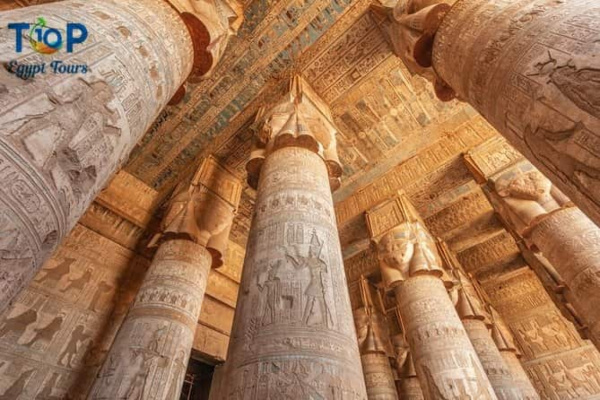Great Hypostyle Hall Of Karnak Temple, Nestled on the east bank of the Nile River in the ancient city of Thebes, the Karnak Temple Complex stands as a testament to the grandeur of ancient Egyptian architecture and the ingenuity of its builders. Among the many remarkable structures within Karnak, the Great Hypostyle Hall stands out as a colossal masterpiece, captivating visitors with its awe-inspiring design and historical significance.
Unraveling the Mysteries of Karnak Temple:
Karnak Temple, dedicated primarily to the god Amun, represents one of the largest religious complexes in the world. Constructed over a span of several centuries, it served as the heart of religious worship during the New Kingdom period (c. 1550–1070 BCE). The temple’s vast complex comprises a series of interconnected structures, each contributing to the overall magnificence of the site.
The Great Hypostyle Hall Of Karnak Temple:
“The Great Hypostyle Hall” or “The Great Hypostyle Hall” in the Karnak Temple, saying: “It is the largest hall in the world without pride and one of the most luxurious hypostyle buildings ever built in the history of all mankind.”
The hypostyle hall is 52 meters long and 103 meters wide, and has 134 sandstone columns. These columns are made up of 16 rows. Scientists have unanimously agreed that the initiator of this foyer and its columns was King Amenhotep III.
Scholars unanimously agree that King Seti I was the one who erected the rest of the columns, all 122 in 14 rows and with seven rows on each side. However, the length of the columns is less than that of Amenhotep III, as the height of the column is about 15 meters, taking the shape of papyrus buds. This hall was in his reign. It was roofed on two levels, with two side roofs above its middle. They took advantage of the difference between the ceiling of the three arches and the ceilings of the two side arches by making luxurious windows of stone that allowed light to seep through to illuminate the path of the foyer, that is, the path of the procession of the god. Then his son, King Ramesses II, came and engraved his name on all the columns.
Among the most important scenes on the northern wall of King Seti I, which represent him personally:
The northern wall of Seti I:
King Seti I called this hall “The Temple of the God = Seti Beloved of Ptah the Useful in the Temple of Amun,” and various religious rituals were performed, perhaps the most important of which was the scene representing King Seti kneeling under the sacred tree and the god Djehuti writing his name on its leaves.
On this same wall from the outside, we find a scene of the king fighting with the Asians and his victory over them.
The southern wall of Ramesses II:
The interior scenes on the southern wall of the hypostyle hall represent King Ramesses II in his various relationships with the gods and goddesses. Perhaps what is most interesting to watch is the scene that represents Ramesses II in the garb of the priests, releasing incense in front of the sacred boat of Amun, which the priests carry while wearing the masks of each of the spirits of Butu (with falcon heads). ) And the spirits of Nekhen (with the heads of jackals), then followed on the shoulders of the priests also by both the boat of Khonsu and the boat of Mut.
The external views of this wall represent the wars of Ramesses II in Syria. On the same southern wall, but from the outside, there is a prominent wall on which is engraved the poetic text of the Battle of Kadesh, which is known as the poetry of (Pentaor) in reference to the name of the writer who composed it.
The intricate reliefs adorning the columns and walls depict scenes of religious ceremonies, victories in battle, and offerings to the gods. These detailed carvings provide valuable insights into the religious and political events of ancient Egypt, allowing visitors to step back in time and connect with the rich history of the civilization.
Symbolism and Religious Significance:
The Great Hypostyle Hall served as a sacred space where priests and worshippers gathered for religious rituals and ceremonies. The grandeur of the hall was intended to evoke a sense of awe and reverence for the gods. The elaborate decorations and symbolic representations on the columns reinforced the temple’s role as a divine sanctuary dedicated to the worship of Amun and other deities.
As part of the Egyptian Ancient Thebes: Luxor and Karnak Temples cluster, the Great Hypostyle Hall at Karnak Temple stands as a captivating symbol of ancient Egyptian civilization. Its colossal columns and intricate reliefs transport visitors to a bygone era, allowing them to marvel at the architectural achievements of the past. A visit to Karnak Temple is not just a journey through history but a profound experience that highlights the enduring legacy of ancient Egypt’s architectural brilliance.



Comment (0)